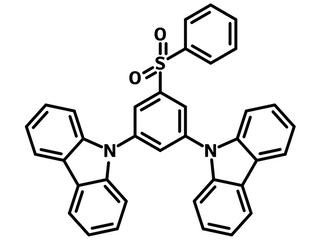mCPSOB
CAS Number 1374770-41-8
Fluorescent Host Materials, High Purity Sublimed Materials, Host Materials, Materials,mCPSOB, ambipolar host TADF material
Ideal host material for blue/deep blue dopants, 9-(3-(9H-Carbazol-9-yl)-5-(phenylsulfonyl)phenyl)-9H-carbazole, CAS No. 1374770-41-8, Sublimed ≥99.0%
9-(3-(9H-Carbazol-9-yl)-5-(phenylsulfonyl)phenyl)-9H-carbazole (mCPSOB) is an ambipolar host thermally activated delayed fluorescence (TADF) material containing two electron-donating carbazole groups and one electron-accepting diphenylsulfonyl group.
mCPSOB has a high energy level of the triplet state (3.02 eV), which suppresses triplet exciton quenching and results in higher external quantum efficiency (EQE). Higher triplet energy level also makes it ideal as a host material for blue/deep blue dopants.
Compared to mCP, mCPSOB has a higher glass transition temperature (Tg = 140 °C). In return, this can prevent mCPSOB from crystallizing during operation and reduces the possibility of phase separation - thus significantly improving device thermal and morphological stability.
General Information
| CAS number | 1374770-41-8 |
|---|---|
| Full name | 9-(3-(9H-Carbazol-9-yl)-5-(phenylsulfonyl)phenyl)-9H-carbazole |
| Chemical formula | C36H24N2O2S |
| Molecular weight | 548.65 g/mol |
| HOMO/LUMO |
HOMO 5.8 eV, LUMO 2.5 eV; ES = 2.93 eV, ET = 3.02 eV [1] |
| Synonyms | 3,5-Di(carbazol-9-yl)-1-phenylsulfonylbenzene |
| Classification / Family | Carbazole derivatives, Light-emitting diodes, Organic electronics, TADF blue/green host materials, Ambipolar materials, Sublimed materials. |
Product Details
| Purity | Sublimed >99.0% (HPLC) |
|---|---|
| Melting point |
TGA > 200 °C (0.5% weight loss) Tg = 140 °C |
| Appearance | Off-white powder/crystals |
*Sublimation is a technique used to obtain ultra pure-grade chemicals. For more details about sublimation, please refer to the Sublimed Materials.
Chemical Structure
Device Structure(s)
| Device structure | ITO/MoO3 (15 nm)/Poly-TriCZ (50 nm)/mCPSOB:4CzIPN (25 nm)/TPBi (60 nm)/LiF (1 nm)/Al (100 nm) [1] |
|---|---|
| Color | Green |
| Current Efficiency@10 cd/m2 | 80.6 cd/A |
| EQE@10 cd/m2 | 26.5% |
| Power Efficiency@10 cd/m2 | 79 lm W-1 |
*For chemical structure information, please refer to the cited references.
Pricing
| Grade | Order Code | Quantity | Price |
|---|---|---|---|
| Sublimed (>99%) | M2120A1 | 250 mg | £320 |
| Sublimed (>99%) | M2120A1 | 500 mg | £520 |
| Sublimed (>99%) | M2120A1 | 1 g | £900 |
MSDS Documentation
Literature and Reviews
- Highly efficient Organic Light-Emitting Diodes from thermally activated delayed fluorescence using a sulfone–carbazole host material, M. Gaj et al., Org. Electronics, 16, 109–112 (2015); DIO: 10.1016/j.orgel.2014.10.049.
- Perspective on carbazole-based organic compounds as emitters and hosts in TADF applications, B. Wex et al., J. Mater. Chem. C, 5, 8622 (2017); DOI: 10.1039/c7tc02156a.
- Purely Organic Thermally Activated Delayed Fluorescence Materials for Organic Light-Emitting Diodes, M. Wong et al., Adv. Mater., 29, 1605444 (2017); DOI: 10.1002/adma.201605444.

